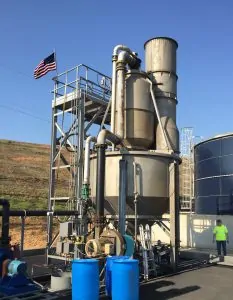

Managing landfill leachate is increasingly challenging and costly. In some cases, publicly owned treatment works (POTWs) are imposing limitations on leachate received at their facilities, increasing their charges, or refusing leachate altogether. These developments are due in part to stringent regulations and the shift to new technology that is less suitable for treating leachate. Many landfill operators are facing higher costs and fewer options for landfill leachate disposal.

Drawing on decades of landfill experience, SCS Engineers can find practical, cost-effective, and innovative solutions to these problems. Rather than focusing solely on the downstream treatment of leachate, SCS Engineers also looks for opportunities to prevent leachate production at every stage: landfill design, construction, operation, and management.
Our leachate management alternatives analyses can provide options, including leachate treatment with NPDES discharge, leachate pretreatment and discharge to a POTW, POTW treatment without pre-treatment, evaporation, recirculation, hauling vs. force mains, deep well injection, among others. We also offer a powerful tool for tracking and analyzing leachate information from multiple data collection points. SCSeTools® Leachate Module enables our clients to evaluate disposal trends and effectively manage disposal costs.
We often work with clients concerned about condensate, which tends to be much more concentrated than leachate. Often condensate management is centered on dewatering the well field and gas collection system. A portion gets recirculated back into the landfill vs. being treated. However, there are many cases where it is collected and comingled with leachate for treatment or disposal.
Our pioneering breakthroughs come from a holistic approach, which uses the landfill itself as an asset in leachate management. Our approach results in important benefits for our clients, some of which are listed here:
You may want to watch our December 2021 forum on how preplanning helps identify leachate treatment and disposal options before you need them. This in-depth 70-minute video includes exchanges with clients and case studies and is available on-demand here.
It is more efficient and cost-effective to reduce the formation of leachate in the first place by optimizing the landfill design and operation. Some ways to achieve this include:
In high precipitation areas, floating covers can be installed over leachate ponds to prevent rainwater from becoming leachate. They can be designed to remove rainwater from the floating cover and collect gases from underneath the floating cover to prevent ballooning. The collected gas can be combined with other landfill gas in the gas management system.
Although we can reduce leachate production with upstream solutions, efficient downstream leachate management, and treatment solutions are still required. The solutions that could become part of the overall landfill leachate management may include:
Treatment systems
Treatment solutions may include the following possible solutions, based on existing equipment, available land, and POTW requirements:
For clients with PFAS issues, SCS can:
Recirculating leachate
One solution we may consider is using the landfill itself to absorb leachate. Recirculating leachate through the landfill can have the added benefit of increasing the production of landfill gas (LFG) that can then be used to fuel leachate evaporators or landfill gas to energy systems.
Leachate evaporators
In some cases, the best solution is to reduce leachate volume with a leachate evaporator. Powered by landfill gas, the evaporator heats up the leachate, driving off the water vapor and leaving behind sludge and solids that can be safely disposed of on the landfill active face. An evaporator may be used on its own, or with other technologies as part of a leachate management system. It is also possible to use powerful and specialized sprays or misters to enhance evaporation from leachate ponds.
Liquids Monitoring using GIS
GIS in the hands of our technical team is making a tremendous difference in managing the operational costs of liquids. Our video contains demonstrations of these capabilities, which at a very low cost are customized to your landfill.
Other options
SCS provides other solutions including deep well injection, which is a cost-effective and state-of-practice means of disposing of leachate. There is also the possibility of mixing the leachate with powdered ash, which creates a sludge that can be reintroduced to the landfill.
But there is no ‘one size fits all’ solution. SCS uses our experience from thousands of successful landfill leachate projects and our extensive understanding of landfills to create the most cost-effective and robust leachate management program for your situation. Our experience makes a difference:
4,300+ LFG | leachate projects
600+ LFG | leachate systems constructed
300+ Active LFG systems currently operating